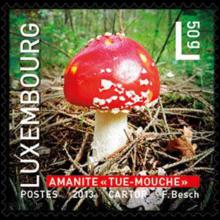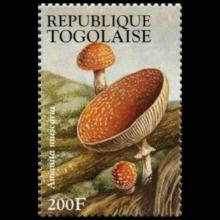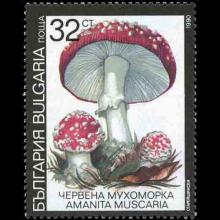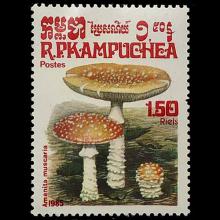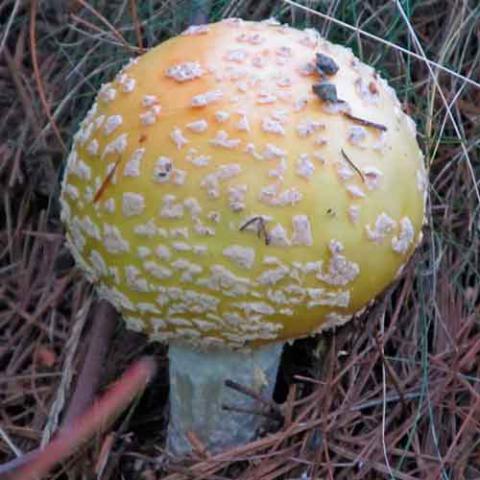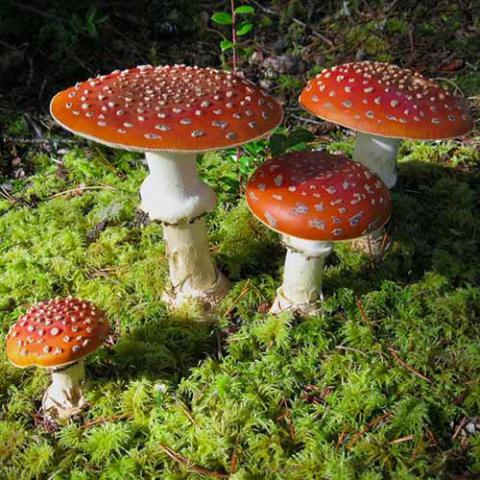NAMES
TAXONOMY
FUNGI ID
THERAPEUTIC
Luxembourg
Issued:
Stamp:
Amanita muscaria
Togo
Issued:
Stamp:
Amanita muscaria
Bulgaria
Issued:
Stamp:
Amanita muscaria
Cambodia
Issued:
Stamp:
Amanita muscaria
Luxembourg
Issued:
Stamp:
Amanita muscaria
Togo
Issued:
Stamp:
Amanita muscaria
Bulgaria
Issued:
Stamp:
Amanita muscaria
Cambodia
Issued:
Stamp:
Amanita muscaria
Luxembourg
Issued:
Stamp:
Amanita muscaria
Togo
Issued:
Stamp:
Amanita muscaria
Bulgaria
Issued:
Stamp:
Amanita muscaria
Cambodia
Issued:
Stamp:
Amanita muscaria
A Mushroom Out of a Fairy Tale That You Might Find in the Forest
By Joanna Klein,Oct. 17, 2017
The fly agaric is the quintessential mushroom of fairy tales. Its big, bright fruiting bodies scatter in great numbers across mossy forests of North America and Europe. They emerge from the soil first like white eggs, abandoned by some mysterious creature of the woods. They can grow up to a foot tall, as warts appear on the cap. The mushroom often blushes red in the process. Finally, they crack open and flatten into a polka-dot disc that would make a gnome’s perfect dinner plate. Recently mushroom hunters and nature lovers have been sharing photos of their fly agaric finds on Facebook, Twitter and Instagram. Perhaps the most striking images came from Hungary, in a Facebook post, which included a video and a photo of a mushroom as big as a child. For many Eastern Europeans, mushroom hunting is a tradition. For some, it’s also a way to earn extra cash. For Csaba Reisz, a fertilizer salesman and soil nutrition consultant in southern Hungary, it’s escape from work stress. “I make everything right with a little mushroom hunting and photo shooting,” he wrote in an email.
A few times a month, he wanders the forest looking for fungal beauty and shows his children the best finds. Between September and November in his area, Mr. Reisz often finds the fly agaric, scientifically known as Amanita muscaria, like this patch discovered on Oct. 9.
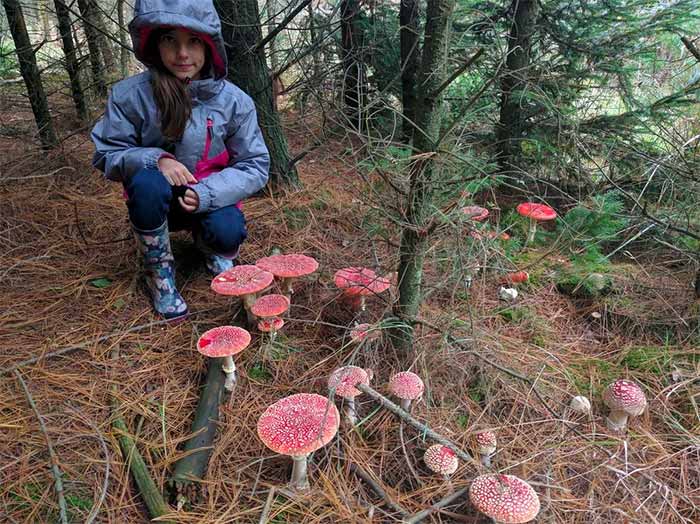
Viktoria Reisz, Csaba Reisz’s daughter, with Amanita muscaria mushrooms earlier this month in a forest near Pécs, Hungary.Credit...Csaba Reisz
“I found the fairy in the fairy-tale forest,” he wrote in a caption for the image above.
These giant shrooms typically pop up in acidic soils near spruce, oak or birch trees and when they get enough rain. While Mr. Reisz admires them, he probably won’t be feeding these magical-looking mushrooms to his children. They contain two mind-altering neurotoxins called ibotenic acid and muscimol which are known to affect humans and other animals.
They are called the fly agaric because in some places, people lace milk with bits of it to lure and kill flies. The insects become inebriated, crash into walls and die, according to the blog of Tom Volk, a mycologist at the University of Wisconsin, La Crosse.
Strange things can happen when mammals ingest them, too. In January, news reports suggested that eating fly agaric fungi made fearless coyotes terrorize motorists in the moonlight in California. Reindeer historically have tripped on them too, and in some places fly agaric has even been associated with Christmas. Some historians even chalk the victories of Viking “Beserker Warriors” to the fearlessness induced after ingesting Amanita muscaria.
In studies using rats, muscimol was infused into parts of the amygdala, a brain region that is known to process emotional fear memories in humans. The drug shut down the rats’ ability to learn about and respond to threats.
But in humans, it can also do the opposite. Its effects range from dry mouth and rapid heartbeat to euphoria, hallucinations, feeling closer to God and fear.
Incorrect doses or preparations are poisonous. In at least one case, doctors found the fly agari in the stomach contents of a person found in a coma. Additionally, Amanita muscaria are often confused with relatives: deadly impostors known as the death cap and the destroying angel.
Mr. Reisz thinks that maybe the mushrooms he found were able to get so big and numerous because of recent weather, and that other locals, seeking them for their psychoactive properties, had not yet picked them.
If this fairy tale now sounds like a nightmare, then look, but don’t ingest.
Genus species (Fungi): Amanita muscaria
The name of the mushroom in many European languages is thought to be derived from its use as an insecticide when sprinkled in milk. This practice has been recorded from Germanic- and Slavic-speaking parts of Europe, as well as the Vosges region and pockets elsewhere in France, and Romania. Albertus Magnus was the first to record it in his work De vegetabilibus some time before 1256, commenting vocatur fungus muscarum, eo quod in lacte pulverizatus interficit muscas, "it is called the fly mushroom because it is powdered in milk to kill flies."
The 16th-century Flemish botanist Carolus Clusius traced the practice of sprinkling it into milk to Frankfurt in Germany, while Carl Linnaeus, the "father of taxonomy", reported it from Småland in southern Sweden, where he had lived as a child. He described it in volume two of his Species Plantarum in 1753, giving it the name Agaricus muscarius, the specific epithet deriving from Latin musca meaning "fly". It gained its current name in 1783, when placed in the genus Amanita by Jean-Baptiste Lamarck, a name sanctioned in 1821 by the "father of mycology", Swedish naturalist Elias Magnus Fries. The starting date for all the mycota had been set by general agreement as January 1, 1821, the date of Fries's work, and so the full name was then Amanita muscaria (L.:Fr.) Hook. The 1987 edition of the International Code of Botanical Nomenclature changed the rules on the starting date and primary work for names of fungi, and names can now be considered valid as far back as May 1, 1753, the date of publication of Linnaeus's work. Hence, Linnaeus and Lamarck are now taken as the namers of Amanita muscaria (L.) Lam..
The English mycologist John Ramsbottom reported that Amanita muscaria was used for getting rid of bugs in England and Sweden, and bug agaric was an old alternate name for the species. French mycologist Pierre Bulliard reported having tried without success to replicate its fly-killing properties in his work Histoire des plantes vénéneuses et suspectes de la France (1784), and proposed a new binomial name Agaricus pseudo-aurantiacus because of this. One compound isolated from the fungus is 1,3-diolein (1,3-Di(cis-9-octadecenoyl) glycerol), which attracts insects. It has been hypothesised that the flies intentionally seek out the fly agaric for its intoxicating properties. An alternative derivation proposes that the term fly- refers not to insects as such but rather the delirium resulting from consumption of the fungus. This is based on the medieval belief that flies could enter a person's head and cause mental illness. Several regional names appear to be linked with this connotation, meaning the "mad" or "fool's" version of the highly regarded edible mushroom Amanita caesarea. Hence there is oriol foll "mad oriol" in Catalan, mujolo folo from Toulouse, concourlo fouolo from the Aveyron department in Southern France, ovolo matto from Trentino in Italy. A local dialect name in Fribourg in Switzerland is tsapi de diablhou, which translates as "Devil's hat".
Reference: Wikipedia
Photo: Stuart Meyers, www.monaconatureencyclopedia.com

